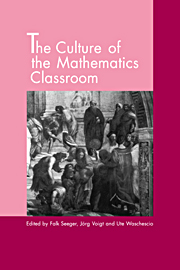Book contents
- Frontmatter
- Contents
- List of contributors
- Acknowledgments
- Introduction
- Part I Changing classroom culture
- Part II Classroom processes
- Part III Epistemology and classroom culture
- 9 The culture of the mathematics classroom and the relations between personal and public knowledge: An epistemological perspective
- 10 Problems of transfer of classroom mathematical knowledge to practical situations
- 11 Cultural perspectives on mathematics and mathematics teaching and learning
- 12 Representations in the mathematics classroom: Reflections and constructions
- 13 Mathematical understanding in classroom interaction: The interrelation of social and epistemological constraints
- Part IV Outlook
- Author index
- Subject index
10 - Problems of transfer of classroom mathematical knowledge to practical situations
Published online by Cambridge University Press: 03 May 2010
- Frontmatter
- Contents
- List of contributors
- Acknowledgments
- Introduction
- Part I Changing classroom culture
- Part II Classroom processes
- Part III Epistemology and classroom culture
- 9 The culture of the mathematics classroom and the relations between personal and public knowledge: An epistemological perspective
- 10 Problems of transfer of classroom mathematical knowledge to practical situations
- 11 Cultural perspectives on mathematics and mathematics teaching and learning
- 12 Representations in the mathematics classroom: Reflections and constructions
- 13 Mathematical understanding in classroom interaction: The interrelation of social and epistemological constraints
- Part IV Outlook
- Author index
- Subject index
Summary
In this chapter, I want to consider the problematical relationship between the mathematics learned in the mathematics classroom and the “math” which is used in practical situations outside the school. I shall examine traditional and “alternative” views of the relationship between the two kinds of mathematics – according to their conceptions of the context of mathematical thinking, and of the relationship between cognition and context. I set out the features that need to be considered in a more satisfactory account of thinking-in-context. I then expand on this notion of contexted cognition and illustrate its use in research on numerate thinking and affect among adult students, using in-depth consideration of a case study. Finally, I put forward some conclusions about the ways that the problem of transfer should be considered by mathematics educators.
Two views of mathematics and transfer
The “transfer” of learning can be considered to refer in general to the use of ideas and knowledge from one context in another. It often is used particularly for the “application” of knowledge from academic contexts to work or everyday activities. This is clearly a central problem of training, and also for most conceptions of education. It is especially important for mathematics. Of all the subjects taught and learned at school, it is one of those claimed to have the widest applicability outside school. However, at the same time, it is perhaps the subject in which the classroom at school (as opposed to outside activities) provides the context for the greatest part of children's learning and problem solving – though not for all of it.
- Type
- Chapter
- Information
- The Culture of the Mathematics Classroom , pp. 269 - 289Publisher: Cambridge University PressPrint publication year: 1998
- 5
- Cited by



